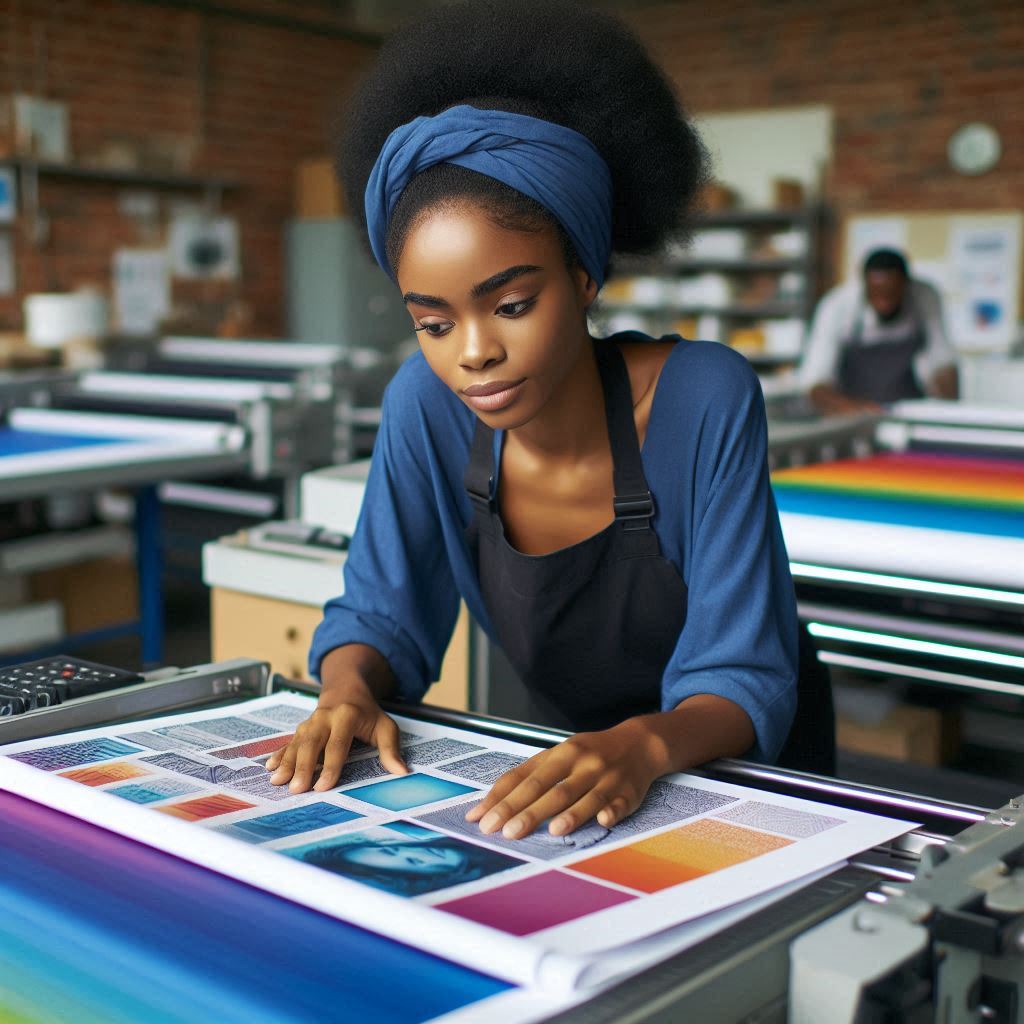Introduction
The printing industry in Nigeria has undergone significant transformations, especially with the adoption of modern printing techniques.
These advancements have revolutionized how printing services are delivered, catering to a wide range of industries and sectors across the country.
Recently, Nigeria has embraced digital printing technologies, offering benefits like faster turnaround times, enhanced print quality, and efficient variable data handling.
Brief Overview of Printing Industry in Nigeria
Nigeria’s printing industry is diverse and multifaceted, comprising small-scale print shops to large commercial printing enterprises.
It supports sectors like publishing, advertising, packaging, and education, playing a crucial role in the country’s economy.
The industry has evolved from traditional offset printing to embracing digital and flexographic printing methods, which are more adaptable to modern printing needs.
Importance of Modern Printing Techniques in the Digital Age
In today’s digital age, the importance of modern printing techniques cannot be overstated. These techniques enable printers to offer personalized printing solutions, high-definition graphics, and quick production cycles.
They also support sustainable practices through the use of eco-friendly materials and efficient resource management.
For Nigerian printers, adopting modern techniques ensures competitiveness, meets client expectations for quality and innovation, and fuels printing sector growth.
By leveraging modern printing technologies, Nigerian printers can not only enhance their operational efficiency but also expand their service offerings to attract a broader clientele.
Embracing these advancements positions the industry to thrive in a digital-centric future, where agility and adaptability are key to success.
History of printing in Nigeria
Evolution of Printing Techniques in Nigeria
The history of printing in Nigeria dates back to the pre-colonial era when traditional methods were used to produce various forms of written materials. These methods included hand-carved stamps, woodblock printing, and calligraphy techniques.
With the advent of colonialism, the printing industry in Nigeria witnessed a significant transformation as modern printing techniques were introduced.
This transition was fueled by the impact of technology on the printing industry, leading to the adoption of more efficient and advanced methods.
Traditional Printing Methods
- Hand-Carved Stamps: This method involved the carving of symbols or letters onto a piece of wood or rubber, which was then dipped in ink and stamped onto paper or cloth.
- Woodblock Printing: Woodblock printing was another traditional technique that utilized a carved wooden block to transfer ink onto a medium, such as paper or fabric.
- Calligraphy: Calligraphy, the art of beautiful handwriting, was also a common method of producing written materials before the introduction of printing presses.
Modern Printing Techniques
- Offset Printing: Offset printing is a widely used modern technique that involves transferring an inked image from a plate to a rubber blanket, then onto the printing surface.
- Digital Printing: Digital printing is a method that uses computers to transfer digital images directly onto paper or other substrates, allowing for quick and cost-effective printing.
- Screen Printing: Screen printing involves using a mesh screen to transfer ink onto a substrate, making it popular for printing on various materials like shirts, banners, and posters.
Impact of Technology on the Printing Industry in Nigeria
The introduction of technology into the printing industry in Nigeria has revolutionized the way printed materials are produced and distributed. This impact can be seen in various aspects of the industry, including:
Efficiency
Modern printing techniques have significantly increased the efficiency of the printing process, allowing for faster turnaround times and higher print quality. With digital printing, for example, multiple copies of a document can be produced in minutes.
Cost-Effectiveness
Technology has also made printing more affordable for both businesses and individuals. With digital printing, there are no setup costs or minimum print quantities, making it a cost-effective option for short print runs.
Versatility
Modern printing techniques have broadened the range of printable materials, enhancing versatility in product offerings. Screen printing, for example, can be used to print on surfaces such as glass, metal, and plastic.
Customization
Technology has enabled the printing industry to offer more personalized printing services to customers. Digital printing, in particular, allows for easy customization of printed materials, such as personalized business cards or invitations.
Basically, the evolution of printing techniques in Nigeria from traditional to modern methods has been driven by the impact of technology on the printing industry.
This evolution has led to increased efficiency, cost-effectiveness, versatility, and customization in the production of printed materials.
Read: ICT Training Centers and Programs in Nigeria
Types of modern printing techniques
When it comes to modern printing techniques in Nigeria, there are several options available for businesses and individuals alike.
These techniques have revolutionized the printing industry, making it easier and more efficient to produce high-quality materials.
Here are some of the most common types of modern printing techniques:
Digital Printing
Digital printing is a popular printing technique that involves transferring digital files directly onto a variety of surfaces such as paper, cardstock, and fabric.
This process is quick, cost-effective, and produces high-quality prints with vibrant colors and sharp details.
Digital printing is ideal for small to medium-sized print runs and can be used for a wide range of products including business cards, brochures, flyers, and more.
Offset Printing
Offset printing is a traditional printing method that involves transferring ink from a plate to a rubber blanket, which then transfers the ink onto paper.
This technique is ideal for large print runs and produces high-quality prints with consistent color and sharp detail. Offset printing is commonly used for items such as magazines, newspapers, books, and marketing materials.
Flexography
Flexography is a versatile printing technique that uses flexible plates to transfer ink onto a variety of substrates such as paper, plastics, and films.
This method is ideal for printing on packaging materials, labels, and other products that require high-speed production and precise color registration.
Flexography is known for its ability to produce vibrant, durable prints that can withstand various environmental conditions.
Screen Printing
Screen printing is a popular technique that involves transferring ink onto a substrate through a mesh screen. This method is often used for printing on textiles, such as T-shirts, tote bags, and posters.
Screen printing is known for its ability to produce vibrant colors and long-lasting prints that are ideal for promotional and branding purposes.
Overall, modern printing techniques have revolutionized the way we create and produce printed materials.
Whether you’re looking to print business cards, packaging materials, or promotional items, there is a printing technique that can meet your needs and deliver high-quality results.
Read: Role of ICT in Nigeria’s Education System
Advantages of modern printing techniques
Modern printing techniques in Nigeria offer numerous advantages that make them a preferred choice for businesses and individuals alike. Let’s explore some of these benefits in more detail:
Faster Turnaround Time
One of the key advantages of modern printing techniques is their ability to deliver faster turnaround times. With advancements in technology, printing processes have become more efficient, allowing for quick production of prints.
This is especially beneficial for businesses that require urgent printing jobs, such as last-minute marketing materials or event invitations.
High Quality Prints
Modern printing techniques also ensure high quality prints that meet the expectations of customers. The use of advanced equipment and printing technologies results in sharp, crisp images with vibrant colors.
This is crucial for businesses looking to make a strong visual impact with their printed materials and establish a professional reputation.
Cost-effective
Another advantage of modern printing techniques is their cost-effectiveness. While the initial investment in modern printing equipment may seem high, the long-term savings are substantial.
With efficient processes and reduced wastage, businesses can produce high-quality prints at a lower cost per unit, ultimately saving money in the long run.
Environmentally Friendly
Modern printing techniques are also environmentally friendly, as they often involve sustainable practices and the use of eco-friendly materials.
With a focus on reducing waste and energy consumption, these techniques help minimize the environmental impact of printing operations.
This is not only beneficial for the planet but also for businesses looking to demonstrate their commitment to sustainability.
Generally, the advantages of modern printing techniques in Nigeria are clear. Modern printing techniques offer benefits such as faster turnaround times, high-quality prints, cost-effectiveness, and environmental friendliness, essential for business success.
By embracing modern printing technologies, businesses can enhance their brand image, streamline their printing processes, and contribute to a more sustainable future.
Read: How Wireless Technology Boosts Nigerian Economy
Challenges faced by printing companies in adopting modern techniques
In Nigeria, the printing industry is constantly evolving with the advancement of technology. However, many printing companies face challenges when it comes to adopting modern printing techniques.
These challenges often hinder their ability to stay competitive in the market and meet the demands of their customers.
Lack of skilled labor
One of the major challenges faced by printing companies in Nigeria is the lack of skilled labor. With the introduction of modern printing techniques, there is a need for employees who are proficient in using new equipment and software.
Unfortunately, finding such skilled labor can be difficult in Nigeria, as there is a shortage of trained professionals in the printing industry.
Printing companies often have to invest time and resources in training their employees to use new technologies effectively. This can be a costly process and may lead to delays in adopting modern techniques.
Additionally, the turnover rate for trained employees can be high, further exacerbating the issue of a lack of skilled labor in the industry.
High cost of equipment
Another challenge that printing companies face in adopting modern techniques is the high cost of equipment. Investing in new printing machinery, software, and materials can be a significant financial burden for companies, especially smaller ones.
The cost of technology upgrades and maintenance can also add to the overall expenses for printing companies.
Due to the high cost of equipment, many printing companies in Nigeria may be reluctant to invest in modern printing techniques.
This can hinder their ability to improve efficiency, quality, and output, ultimately impacting their competitiveness in the market.
Finding affordable financing options or seeking partnerships with equipment suppliers may help mitigate this challenge for printing companies.
Competition from foreign companies
Additionally, printing companies in Nigeria face competition from foreign companies that have already adopted modern printing techniques.
Foreign companies may have access to advanced technology, skilled labor, and financial resources that give them a competitive edge over local printing businesses.
This can make it challenging for Nigerian companies to attract and retain customers in the market.
To stay competitive in the face of foreign competition, printing companies in Nigeria must invest in modern printing techniques to enhance their capabilities and offer unique services to clients.
Local printing companies can succeed by building strong customer relationships, offering excellent service, and differentiating from foreign competitors.
Therefore, while modern printing techniques offer benefits for Nigerian printing companies, they face adoption challenges.
Addressing issues such as a lack of skilled labor, high equipment costs, and competition from foreign companies requires strategic planning, investment, and innovation.
By recognizing and addressing these challenges, printing companies in Nigeria can position themselves for growth and success in the evolving printing industry.
Read: ICT Training Centers and Programs in Nigeria

Role of government in promoting modern printing techniques
Support for Training Programs
In Nigeria, support for training programs in modern printing techniques is crucial for advancing the industry. These programs equip professionals with updated skills in digital printing, offset printing, and flexographic printing.
By enhancing expertise, training initiatives improve print quality and efficiency, meeting the demands of diverse clients across sectors.
Incentives for Investment in Modern Printing Equipment
Government incentives play a pivotal role in encouraging investment in modern printing equipment. Tax breaks, grants, and subsidies help offset the initial costs of purchasing advanced printers, digital presses, and finishing equipment.
These incentives aim to modernize the printing infrastructure, boost productivity, and enhance the industry’s competitiveness on a global scale.
Regulations to Ensure Quality Standards
Regulations are essential to maintain high-quality standards in Nigeria’s printing industry. Government agencies enforce guidelines on print materials, ink quality, and production processes to uphold consistency and reliability.
Compliance with these standards ensures that printed materials meet customer expectations and adhere to environmental sustainability practices.
Stringent regulations promote fair competition and consumer confidence, safeguarding printing businesses’ reputation and industry credibility.
Ensuring robust support for training programs is vital for nurturing a skilled workforce capable of leveraging modern printing technologies effectively.
By investing in continuous education and skill development, Nigeria can cultivate a pool of competent professionals ready to innovate and adapt to industry advancements.
Transform Your Career with Expert Guidance
Get personalized mentorship consulting that’s tailored to your unique path. Our expert advice is actionable and exclusive.
Get StartedMoreover, providing incentives for investment in modern printing equipment stimulates economic growth within the sector.
Accessible financial support encourages printers to upgrade their technology, expand service offerings, and attract new business opportunities.
This strategic investment fosters job creation, enhances operational efficiency, and positions Nigerian printers as leaders in the regional and global markets.
Furthermore, regulatory frameworks that uphold quality standards are integral to sustaining industry growth.
By enforcing stringent guidelines, authorities safeguard against substandard practices and ensure consistent product quality and safety.
Compliance with regulations fosters trust among consumers and business partners, promoting long-term sustainability and ethical business practices in the printing sector.
Most Importantly, supporting training programs, investment incentives, and regulatory oversight is crucial for advancing modern printing techniques in Nigeria.
Aligning these efforts propels the printing industry towards innovation, competitiveness, and sustainability, fostering economic development and meeting market demands.
Case studies of successful printing companies in Nigeria
How they have embraced modern printing techniques
These successful printing companies in Nigeria have embraced modern printing techniques by investing in the latest printing equipment, software, and technology. They have also trained their staff to use these tools effectively.
Print Magic, for example, has trained its designers in using design software to create unique and eye-catching prints for its clients.
Print Crafters has invested in UV printing technology to offer high-quality prints with faster turnaround times.
Superior Prints has integrated web-to-print technology into its website, allowing customers to place orders online and customize their prints easily.
By embracing these modern techniques, these companies have stayed ahead of the competition and met the evolving needs of their customers.
Impact on their business growth and profitability
The adoption of modern printing techniques has had a significant impact on the business growth and profitability of these printing companies in Nigeria.
By investing in state-of-the-art equipment and software, they have been able to offer higher quality prints at competitive prices.
This has attracted more customers and increased their market share in the industry. Using modern printing techniques, these companies fulfill orders faster with fewer errors, boosting customer satisfaction and retention.
Print Magic, Print Crafters, and Superior Prints lead Nigeria’s printing industry by boosting revenue and profitability with modern techniques.
Future trends in modern printing techniques in Nigeria
Introduction of 3D printing
3D printing is revolutionizing the printing industry in Nigeria by offering innovative, cost-effective solutions for various sectors.
The technology allows for the creation of three-dimensional objects from digital models, opening up endless possibilities for customization and rapid prototyping.
With the introduction of 3D printing in Nigeria, businesses can now create prototypes, spare parts, and even personalized products with ease.
This technology is gradually changing the landscape of manufacturing in the country, as more companies embrace its advantages.
As 3D printing becomes more accessible and affordable, we can expect to see a rise in its utilization across different industries in Nigeria.
This trend will drive innovation and creativity, leading to the development of unique products and solutions that cater to specific needs.
Emphasis on sustainable printing practices
In recent years, there has been a growing emphasis on sustainable printing practices in Nigeria. Printers are now adopting eco-friendly materials and processes to reduce their environmental impact and promote sustainability.
Nigerian printing companies reduce their carbon footprint by using recycled paper, vegetable-based inks, and energy-efficient equipment.
This shift towards sustainable printing practices is not only beneficial for the environment but also for business reputation and customer trust.
In the future, we can expect to see a greater focus on eco-friendly printing methods in Nigeria as more businesses prioritize environmental stewardship.
This trend will lead to a more sustainable printing industry that actively works towards preserving our planet for future generations.
Integration of digital and traditional printing methods
The integration of digital and traditional printing methods is another future trend shaping the printing industry in Nigeria.
By combining the strengths of both approaches, printers can offer a more comprehensive range of services to meet diverse customer needs.
Digital printing allows for quick turnaround times and personalized products, while traditional printing methods like offset printing offer high-quality results for large volume jobs.
By integrating these techniques, printers in Nigeria can cater to a wider customer base and deliver customized solutions efficiently.
This trend towards the integration of digital and traditional printing methods will continue to grow as the industry evolves.
It represents a symbiotic relationship between technology and craftsmanship, providing customers with the best of both worlds in terms of speed, quality, and customization.
Conclusion
In closing, modern printing techniques represent a critical evolution in Nigeria’s printing industry, offering enhanced capabilities and efficiency.
The adoption of digital printing, offset printing advancements, and flexographic innovations has significantly improved print quality and production speed.
These advancements are not just technological upgrades but essential tools for meeting diverse client demands across sectors such as publishing, packaging, and advertising.
Moving forward, it is imperative for printing companies in Nigeria to embrace these modern techniques fully.
By investing in state-of-the-art equipment and continuously upgrading their skills through training programs, printers can position themselves as leaders in the industry.
This proactive approach ensures competitiveness, drives innovation, and supports business growth in today’s digital age.
To thrive in the evolving marketplace, printing companies must seize the opportunities presented by modern printing technologies.
By doing so, they can meet the growing expectations of clients, expand their service offerings, and contribute to the overall advancement of the printing industry in Nigeria.




